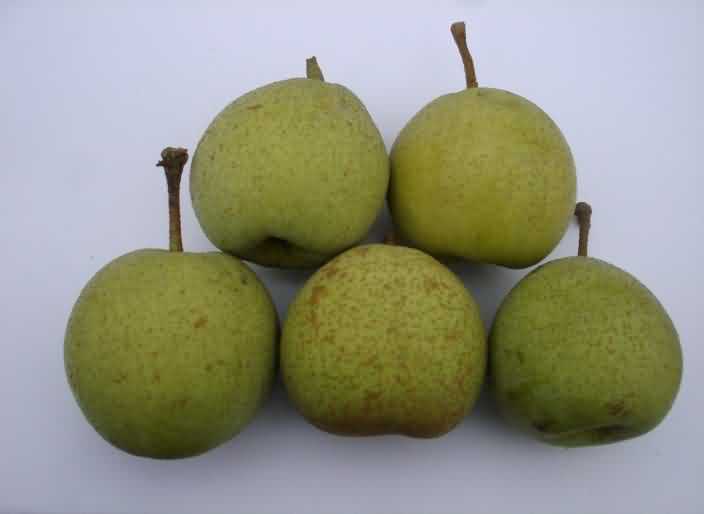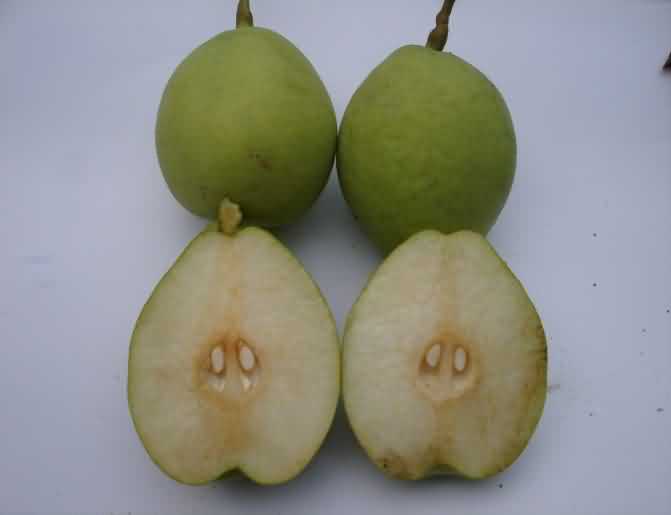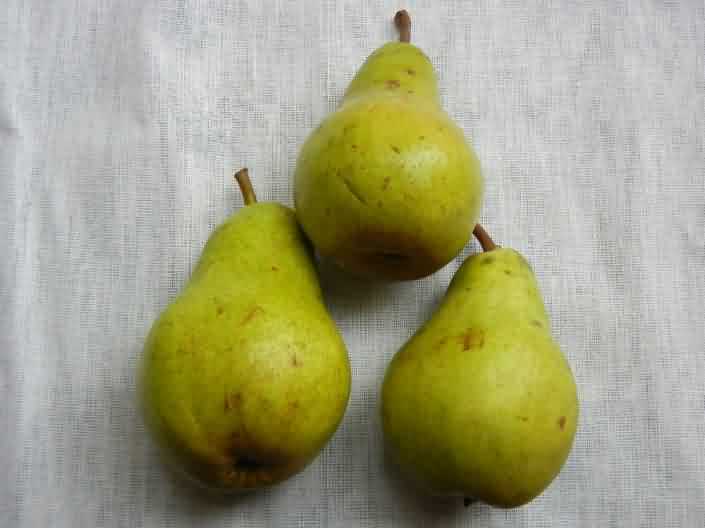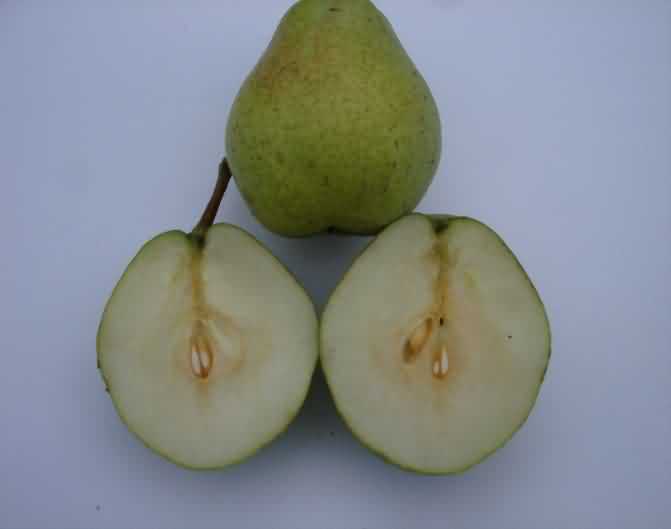भारत के उपोष्णकटिबंधीय क्षेत्रों मे कम सर्द नाशपाती के उत्पादन की प्रौद्योगिकी


Pear, an important fruits of the temperate region, belongs to the family Rosaceae. In India pear cultivation is mainly confined to the temperate Himalayan mountains at 1,700-2,400 m above mean sea level which have ideal conditions to grow a large number of European (Pyrus communisL.) and oriental [P. pyrifolia (Burm.) Nakai ] pears.
Selection and development of low chill pear cultivars had made it possible to grow pear in subtropical regions of India also. Now pear is cultivated as a commercial crop under the tarai region of Uttar Pradesh, Punjab and Uttrakhand because these area has a typical subtropical climate with cold winters, necessary for meeting chilling requirement and mild temperature, suitable for flowering and better fruit set.
it is highly nutritious in nature, having 0.7 g protein, 4.0 g fiber, 13.0 mg calcium, 16.0 mg phosphorus, 0.3 mg iron, 20.0 IU vitamin A, 0.02 mg thiamine, 0.04 mg riboflavin, 0.1 mg nicotinic acid and 4.0 mg ascorbic acid per 100 g edible fruit.
Soil and climatic requirement for low chill pear :
Although under hilly area, pear require about 1200 hours of chilling temperature below 70C for satisfactory flowering and fruiting but a large number of low chill pear cultivars are grown under subtropical plains which require very low chilling temperature of less than 700 hours. Cultivar Patharnakh fruits heavily even at 150 chiiling hours and can withstand high temperatures and hot winds during the summers. Apart from this, other cultivars like Kieffer, Baggugosha, Patharnakh, Le Conte, Gola, Pineapple Hood, China pear also performs well in subtropical tarai condition with mild winters.
One of the major limitations of pear production is the spring frost, which may kill the blossoms completely and will make the orchard unproductive. Hence, proper air circulation is necessary in the vicinity of a pear orchard, which can be achieved by avoiding low lands as well as hail prone localities. The land for pear cultivation must be slightly higher level than the surrounding area and land should be selected on northern aspect.
Pear can grow on a wide variety of soils but deep, well drained, fertile, medium textured and relatively more clayey soil with pH around 6.0-7.5 is the best for its successful cultivation. Apart from these it can withstand easily in the wet soil and even in the waterlogged condition. But the trees are short lived on sandy and loam soils. Soil depth of 180cm is ideal for proper root development and heavy fruit production. Plant grown in the deeper soil gives much higher yield as compared to the shallow soils.
Propagation of pear
It is mainly propagated by vegetative means of propagation. T - budding during April-September and tongue grafting during December-January is the commercial method of propagation of pear. Apart from this, other methods of propagation generally followed in pear are-
Seed propagation:
This technique is mainly used for raising rootstock. For that after extraction of seeds from mature fruit, they needs stratification for proper germination which can be done by sowing the seed either in the open nursery in November or by placing them in moist sand and vermiculite layers at a temperature of 5-70C for 60-90 days, until the uppermost layer of seeds pushes the sand layer upward and protrudes the radical. After germination seeds are sown in the nursery bed at a spacing of 10x10 cm or 15x15 cm.
Cuttings:
Cuttings are generallyprepared from juvenile shoots during December. After giving 100ppm IBA treatment for 24 hours, cuttings are placed in the sand for proper callus formation and should be placed in the nursery rows thereafter.
Planting of Pears
The land for establishing a pear orchard needs to be cleared of all the old stems and roots of previously growing trees and shrubs and to be leveled properly giving a gentle slope for water drainage. The layout system depends upon the planting system to be adopted and according to the land topography. Generally, rectangular system is preferred over square system of planting as more number of trees per unit area can easily be accommodated by this system without any adjustment.
In subtropical plains planting is mainly done during December to mid-February when the plants remain in dormant condition. The planting distance depends upon soil fertility, cultivar, rootstock, training system and climate of the region. A planting distance of 6x6m and 8x8m is normally recommended for cultivar Baggugosha and Patharnakh respectively under plain condition. A pit of 1×1×1m size is dug at such places and filled with a mixture of soil and well rotten FYM or compost and 30g Aldrin or BHC dust. After giving proper irrigation a small hole per pit is dug and planting is done in to the holes. Very long roots can be shortened and plant should remain straight in its position when roots are being covered with soil firmly.
During planting, grower should plant pollinizer cultivar as every fourth plant in every fourth row. In addition, placement of two-three bees colonies per hectare is essential for proper pollination and to obtain higher yield.
Training and pruning in Pear
Proper training and pruning is very important in pear for the maintenance of growth and vigor of the plant, proper development of strong framework, optimum spreading of fruiting branches as well to produce bigger size fruits of better quality. Pear trees are normally trained to ‘Modified Central Leader’ system. In this method, one year after planting, plants are headed back at 90-120 cm from the ground level. Lateral branches are allowed to develop at 60 cm height. 4-5 primary laterals arising at wider angle, well spaced, 10-15 cm apart and spirally arranged around the trunk are selected while other should be discarded. 2-3 secondary branches are allowed per primary branches during the following years of training. On the other hand, pruning is done to make the balance between vegetative and reproductive growth. It bears fruit on two years old spurs and the spurs are continued to bear fruit more than six year. Hence, pruning should be planned in such a manner that one-sixth of the fruiting wood replaced in each year. Winter season is the right time for pruning as the plants undergo dormancy during that time.
Manures and Fertilizers
Nitrogen is the only element required for proper nutrition of pear but P and K is also used for getting satisfactory returns. N at 50-100g, P at 25- 50g and K at 50-100g per tree per year of age should be supplied until 6th year and thereafter the rates should be stabilized. High N content of pear foliage makes it highly susceptible to psylla and fire blight attack. Phosphorus deficiency occurs under high pH and is exhibited by leaf margin and tip burn, short terminal growth, die back of new growth and failure of fruits to mature normally. On the other hand, K deficiency causes marginal leaf scorching. Hence, proper fertilization in each and every year is of utmost importance in pear orchard. P and K along with farmyard manure (60-100 kg/ tree) should be applied in December while half N should be applied at 3 weeks before flowering and remaining half just after fruit setting.
After care of Pear
Basin should be prepared immediately after planting and level of soil around the trunk should be kept slightly higher that the level of the basin to avoid the problem of water logging. First irrigation should be done immediately after planning while second one after 2-3 days and subsequent irrigation should be given according to the requirement of the plant.
To keep the stem straight, plants should be staked properly. Apart from this whitewashing of the trunk is also very important to avoid the problem of sunburning.
Thinning out of unwanted shoot should be removed at frequent interval to avoid the overcrowding into the orchard. Sprouts on the rootstocks and root suckers, which are developed around the tree trunk, should also need to remove at frequent interval. Otherwise, it will create competition for nutrient as well as water.
As it is normally planted at a spacing of 6x6 or 8x8, the area in between two plants remains fallow. Hence, these areas can be effectively utilized by planting intercrop in the pear orchard. Gram, toria, sunflower can be grown as intercrop in kharifseason while wheat, pea, gram can be planted in rabi season. Moreover, peach can be planted as filler crop in pear orchard. But one thing should be kept in mind during cultivation of intercrop in Pear orchard that these intercrop will not compete with the main crop for nutrient, water and other factors. Hence, additional fertilizers should be applied to the intercrops.
Weed is a very important drawback in pear orchard, which can be controlled either mechanically by hand weeding or hoeing, or chemically by using herbicides. Diuron @ 4kg/ha as pre-emergence in the first fortnight of March and Glyphosate @3lit/ha as post emergence one should be applied when weeds are 15-20 cm in height.
Irrigation in pears
Scanty irrigation affects the color, composition as well as the quality of the fruit. Hence, proper irrigation is essential. Normally in pear orchard, 75-100 cm irrigation is needed annually, depending upon the texture of the soil. Irrigation should be done after harvesting i.e. from July-August to till October.
Harvesting of low chill Pear
For fresh consumption fruits are harvested at fully mature stage while for distance market it should be harvested when the fruits are mature but still firm and green.
Maturity indices:
- Lenticels of the fruit turn brown on maturity.
- Colour of the fruit changes from dark green to light green and yellow at advanced stage of maturity.
- TSS of the fruit should be 12-13% at maturity.
Fruits should be harvested by giving a gentle twist rather than direct pulling. Generally 2-3 picking at 3-4 days interval is advisable. A well managed pear orchard under subtropical condition normally yields around 20-30 tones/ha.
Pest and Disease Management in Pears
| Pest | Symptom | Control measure |
|
|
|
|
|
|
|
|
|
|
Disease |
|
|
|
|
|
|
|
|
|
|
|


Authors:
Manoj Kundu1*, Ritu Joshi2
1Ph.D. Scholar, Division of Fruits and Horticultural Technology, IARI, New Delhi
2 M.Sc.(Ag.) Horticulture, GBPUA&T, Pantnagar (Uttarakhand)-263145
* e-mail:
